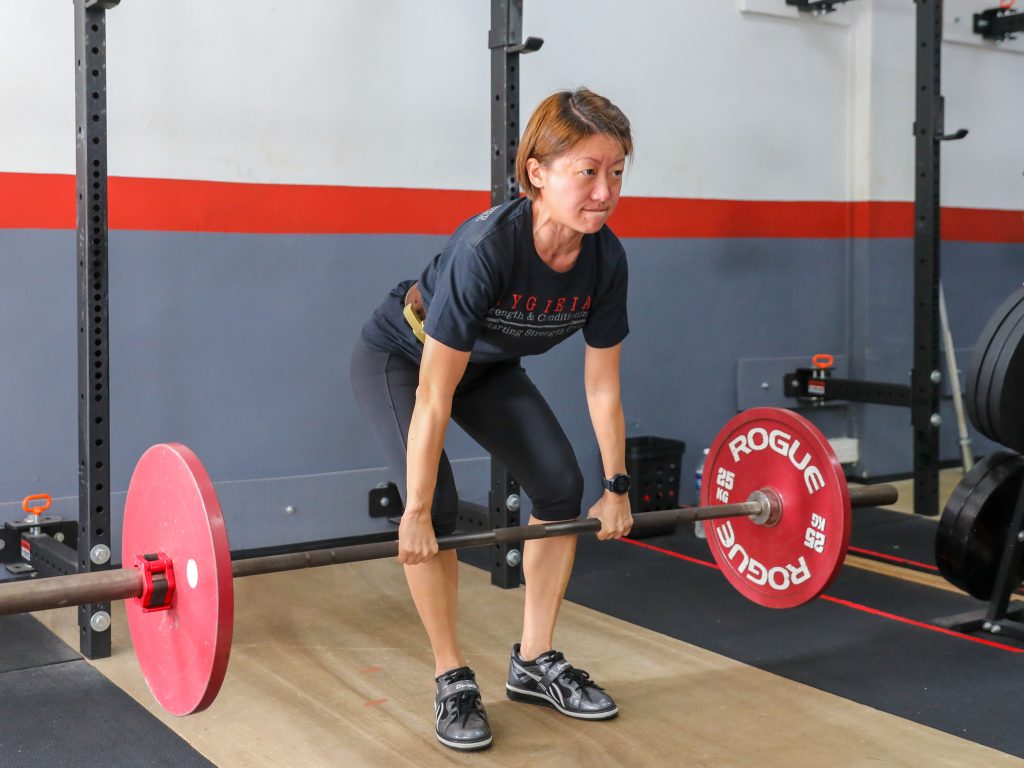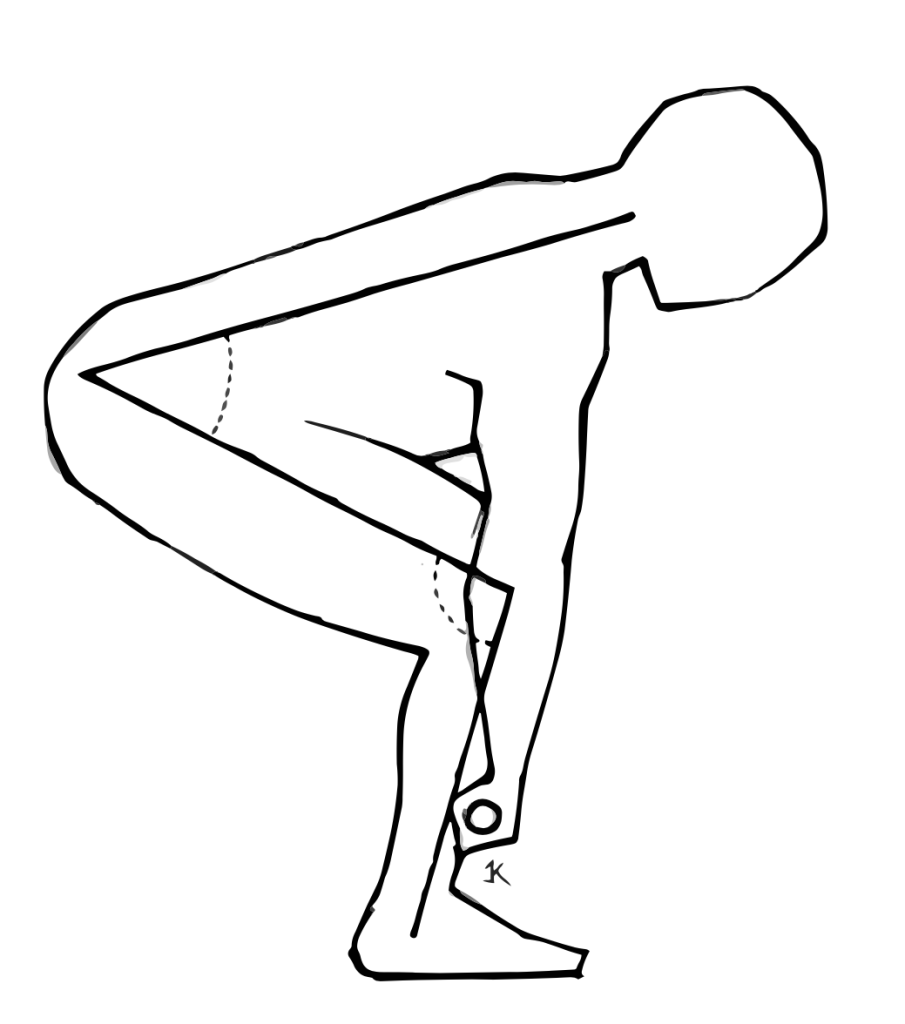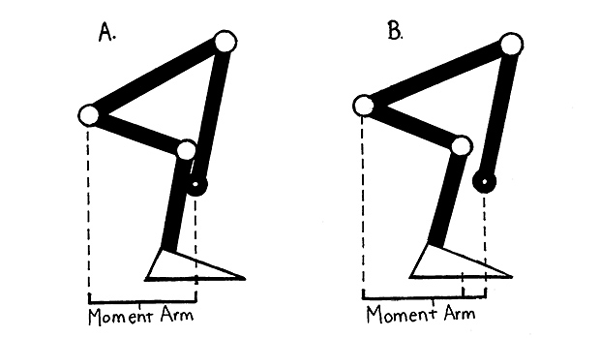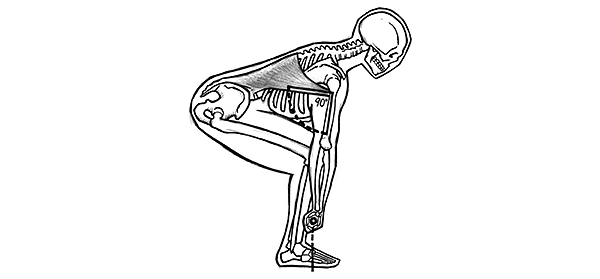
You understand the importance of setting up properly for the deadlift; you even run through the 5 step setup in your head as you walk up to the bar.
But whenever you try to pull a heavy deadlift off the floor, step 5 “Drag the bar up your legs”, eludes you.
The moment the heavy barbell comes off the floor, it swings away from you. You try to correct its path by pulling it back towards your legs, but nothing happens. So you keep pushing as hard as you can. But all the barbell does is hover around mid-shin, refusing to go higher. You run out of steam and the damn thing goes back onto the floor.
You thought you set up well. So why did the bar swing away?
Reviewing the 5-step deadlift setup
First, let’s refresh your memory of the setup. If you haven’t already, check out this classic video from Starting Strength that teaches you how to deadlift.
If you’re more of a text person, here’s our summary of the set up:
Step 1: Take a hip width stance with your shins 2.5 cm from the bar.
Step 2: Bend at the trunk/waist and take a grip on the bar just outside of your feet. Do not move the bar.
Step 3: Bend your knees to bring your shins to the bar. Once the shins touch the bar, stop. Knees out till it contacts your elbows. Do not move the bar.
Step 4: While keeping your hips at the same height, pull your chest up till your entire back down to the lumbar spine is in extension.
Step 5: Drag the bar up your legs.

Done properly, your set up position should look roughly similar to the illustration above. Obviously, the diagnostic angles will differ from lifter to lifter, but the hallmarks of a properly set up deadlift will be similar.
How to tell if you’re properly set up?
• The lifter-barbell system’s (you plus the barbell) combined center of mass is directly over the midfoot
• Shins are in contact with the barbell
• Lats are at 90 degrees to the humerus
• Scapulas are over the barbell
• Shoulders are slightly in front of the barbell
• Back is held in rigid extension
Here’s also a video with 3 reminders for you to self-diagnose your set up position. Follow this quick and easy method, and you should be in the correct pulling position to start.
This sets you up for a vertical bar path – the bar travels vertically up, directly over midfoot, and your shoulders are just forward of the bar until the top.
Basically, when we lift barbells, we’re doing work against gravity. And the most efficient way to do work against gravity is to lift the barbell vertically against the force of gravity.
What happens if the barbell drifts?
When the barbell moves away from the being directly over the midfoot, it introduces unnecessary and inefficient moment arms into the lifter-barbell system. There is now a moment arm between the midfoot and the barbell that previously didn’t exist, and a longer one between the hip and the barbell.
Unnecessary additions or lengthening of moment arms mean that more force will be required to overcome the inefficiencies. (Read more about the fundamentals of moments and forces.)

Because of the lengthened moment arms between your hip and the barbell, and the introduction of a moment arm between your midfoot and the barbell, your back and hip extensors now needs to produce more force to lift the barbell. The back needs to produce more force to maintain its rigid extension and the hip extensors needs to produce more force to keep the barbell moving up.
At the same time, the angle of attack between your lats and humerus will be greater than the most efficient 90 degrees.
On the deadlift, one of the lats’ job is to pull back on the humerus. When the bar drifts away from you, the more open angle reduces its ability to apply the maximum amount of force to pull the bar onto your legs, exacerbating the issue.

When the weights are light, you can still overcome some inefficiencies and recover when the barbell drifts away. But the margin of error gets thinner and thinner the heavier the weight gets. On heavy pulls, even the smallest inefficiency will caused missed reps.
Why does my barbell drift and how to fix it?
From my observations, here are three of the most common causes.
You’re not actively using the lats
In the deadlift, one of the jobs of your lats is to pull the bar in, in order to control the barbell’s tendency to swing away. If you’re not activating contracting your lats, you’re not pulling the barbell into your legs and getting sufficient thoracic extension.
Solution: consciously contract your lats during the set up and throughout the pull. As you extend your back while setting up, pull up your chest and pull your arms/hands and the barbell back into you.
Here’s something I like to do with my clients to emphasize contracting the lats. If you have a training buddy, try this.
Set up for your deadlift. After setting your back into rigid extension, get your buddy to pull the bar away from you. Your job is to not let them pull the barbell away from your shins. This helps you feel what it’s like for the lats to contract and also reinforces pulling the bar into your legs.
You’re kicking the bar away just before the pull
This usually happens either when you’re rushing to pull the bar off the floor, or you’re subconsciously trying get the trunk more upright to “squat” the bar up.
The problem is when your hips drop, your shins go forward and kick the bar away.
Solution: pause before the pull. After you’ve gotten yourself into the correct set up position, add a 1 second pause before starting the pull. This almost always solves the above issues. You can also use that 1 second pause to perform a self-check: is the barbell over midfoot, is your back tight, etc? This should counter the instinct to rush and yank the bar off the floor.
But if after the pause, you’re still dropping your hips and kicking the bar away, try this.
Solution: “Leg press” the floor (use your legs to push the floor away from you) and ease on the power. Instead of going from 0 – 100 immediately, you should gradually push harder and harder through the midfoot. As you get more familiar with the idea of pushing the floor away to initiate the deadlift rather than “squatting” it up, you can gradually speed up the application of power.
You’ve set up too close, which is causing your hips to be too high and shoulders too far forward
When setting up the barbell over the midfoot, it should be about 2.5cm away from your vertical shins (so that they are perpendicular to the floor).
One issue that sometimes occurs is when the lifter tries to measure that 2.5 cm distance, they push their hips back and bend over to see the bar. This causes the shins to move back. If you had set the bar at 2.5 cm from that point, it would be too close when you stand back up straight.
If the bar is too close, the hips will be too high, with the shoulders and scapula too forward. With the shoulders too far forward, the tendency for the bar to drift away increases. This is further exacerbated by the more open lat angle, which decreases the lats’ ability to maximally contract and pull the bar back. This position also has a more open knee angle, which reduces the quad’s contribution to the lift.
Solution: vertical shins and bar over the midfoot.
Make sure your shins are vertical when you set up so that the bar is directly over the midfoot.
Keep on the vertical path
Bar path is key to having a strong deadlift – the most efficient deadlift bar path is vertical, directly over the middle of your foot from start to end. If you’ve been having issues with the barbell drifting away from you on the deadlift, give these fixes a shot. The deadlift will immediately feel easier when the bar is travelling vertically up whilst staying in contact with your legs the entire way.

